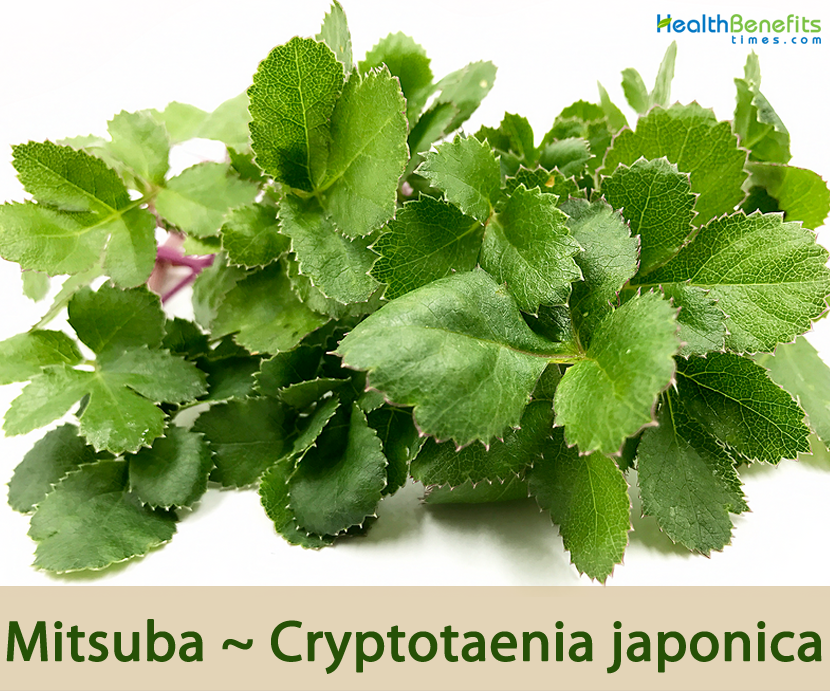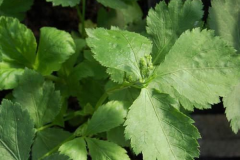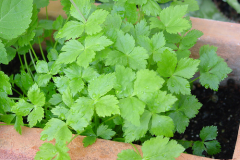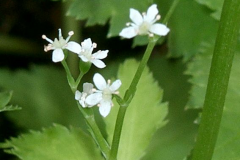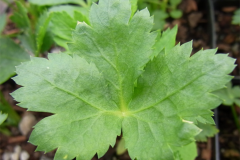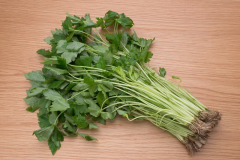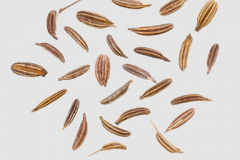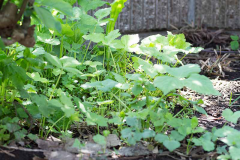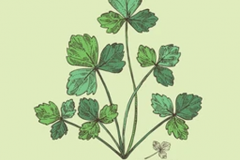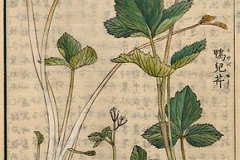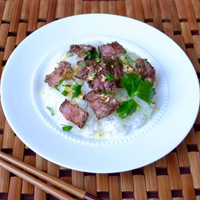Genus name comes from the Greek word cryptos which means hidden and tainia meaning band, ribbon or fillet in probable reference to oil tubes hidden or concealed in the fruits. Specific epithet means of Japan. Plants are frequently used as culinary herbs in Asian cuisine. The plant is harvested from the wild and also commonly cultivated for food in parts of eastern Asia – it is sold in local markets. Leaves and stems are considered to have a parsley/celery-like flavor and may be added to soups, salads or other hot/cold dishes as a flavoring and/or garnish. Roots can be blanched and sautéed. The plant also has medicinal uses. It is also cultivated in gardens as a shade-giving plant.
Mitsuba Herb Facts
| Mitsuba Quick Facts | |
|---|---|
| Name: | Mitsuba |
| Scientific Name: | Cryptotaenia japonica |
| Origin | Northeast China, Korea and Japan, and some says that also those of North America |
| Taste | Slightly bitter in taste |
| Health benefits | • Prevents the Development of Cancerous Cells, Fights Osteoporosis, Promotes Healthy Bones, Control Blood Pressure Level, Promotes Healthy Blood Flow, Great for Heart Health, Natural Immunity Booster, Soothe Nerve System, Relieve Cold, Rich of Antioxidants, Relax Tensed Muscles, Natural Remedy to Sore Throat and Natural Stress Relief |
| Name | Mitsuba |
|---|---|
| Scientific Name | Cryptotaenia japonica |
| Native | Shady places and forests of Northeast China, Korea and Japan, and some says that also those of North America |
| Common Names | East Asian wild parsley, Japanese cryptotaenia, Japanese honewort, white chervil, mitsuba, Japanese wild parsley, stone parsley, honeywort, san ip, trefoil, and san ye qin, Japanese Parsley, Japanese Wild Chervil, Mountain Celery |
| Name in Other Languages | Arabic: Biqadunis bariy yabaniun (بقدونس بري ياباني) Chinese: San ye (三叶), San ye qin (三叶芹), Ya er qin (鸭儿芹), Ya er qin (鴨兒芹), Yā er qín shǔ (鸭儿芹属) English: Japanese cryptotaenia, Japanese honewort, Japanese parsley, Japanese wild parsley, Trefoil, mitsuba Finnish: Japaninyrttiputki French: Persil japonais German: Japanische Petersilie, Kanadische Rispendolde, Kanadische Steinpetersilie, Mitsuba, Dreiblat, japanische Steinpetersilie Japanese: Mitsuba (ミツバ) Hungarian: Japán vadpetrezselyem. Korean: Bandinamul (반디나물), Padudugnamul (파드득나물) Malay: Selderi jepang Persian: کریپتوتائهنیا Polish: Japońska Pietruszka Russian: Skrytnitsa iaaponskaia (Cкрытница японская), Skrytnica Japonskaja, kriptoteniya yaponskaya (криптотения японская) Spanish: Perejil Japones Swedish: Mitsuba, Japansk persilja |
| Plant Growth Habit | Small, herbaceous, evergreen perennial plant |
| Growing Climates | Woodland in hills and mountains, damp places in forests, ditches |
| Plant Size | About 18-24 inches (45.5 to 61 cm.) tall by 8 inches (20.5 cm.) across |
| Leaf | Basal and lower petioles are 5–20 cm long, with oblong sheaths. Blades are triangular to broad-ovate, 2–14 long and 3–7 cm wide. Middle leaflets are rhombic-obovate or cordate, 2–9 cm long and 1.5–10 cm wide. Lateral leaflets are obliquely long-ovate to obovate, 1.5–8 cm long and 1–6 cm wide. |
| Flowering season | July to August |
| Flower | Flowers are star-shaped, small, white, and in umbrella-shaped clusters bloom in summer on stems rising about 6 inches above the foliage |
| Varieties |
|
| Propagation | By seed or by division |
| Flavor | Reminiscent of a blend of Italian parsley, angelica and celery leaves |
| Taste | Slightly bitter in taste |
| Plant Parts Used | Leaves, stems, seeds, and roots |
| Season | August to September |
| Companion Plants |
|
| Health Benefits |
|
| Pests Affecting Mitsuba |
|
Plant Description
Mitsuba is a small, short lived, herbaceous, evergreen perennial plant that normally grows about 18-24 inches (45.5 to 61 cm.) tall and 8 inches (20.5 cm.) across. Depending on climate and conditions it grows, it can be annual, biennial or perennial. The plant is found growing in woodland in hills and mountains, damp places in forests and also ditches. It can grow a multiple new segments of leaves rosettes from one root base, which produce later its own roots. After the flowering, the separate rosette of leaves with flower stalk, dies as soon as the seeds will mature. The other leaves rosettes from that root clump will live until its life cycle will be ended with delivery of seeds too. So in convenient conditions one Cryptotaenia clump can live on for years, if some of its rosettes will not flower before creating new offshoot rosettes. And new Mitsuba plants can be created by clumps division into separate rosettes segments with own roots.
Leaves
Basal and lower petioles are 5–20 cm long, with oblong sheaths. Blades are triangular to broad-ovate, 2–14 long and 3–7 cm wide. Middle leaflets are rhombic-obovate or cordate, 2–9 cm long and 1.5–10 cm wide. Lateral leaflets are obliquely long-ovate to obovate, 1.5–8 cm long and 1–6 cm wide.
Flower & Seed
The flowers are star-shaped, small, white, and in umbrella-shaped clusters bloom in summer on stems rising about 6 inches above the foliage. Flowers are replaced by seeds. Seeds ripen in August-September.
Health benefit of Mitsuba
In Japan, mitsuba is extensively used as cooking seasoning but it is also used as tonic as part of traditional herbs used as medicines. Mitsuba is packed with some nutrients like vitamins and minerals that are beneficial to human health. Listed below are some of the popular health benefits of mitsuba
1. Prevents the Development of Cancerous Cells
Cancerous cells occur with several reasons. Unhealthy habit, free radicals and unhealthy diet are the main root of the problem. Consuming foods that are rich of antioxidants might help preventing the development of cancerous cells while vitamin C will make sure to provide one layer of protection to the immune system. As mentioned previously, mitsuba is an excellent source of vitamin C and antioxidants.
2. Fights Osteoporosis
There is no easy way to deal with osteoporosis. Most people are only finding a way to deal with the pain but not kill the source or find the main factor that causes it. It means, they only deal with temporarily. However, mitsuba consists of some compounds that are not only able to relieve the pain but also deal with it to the main root. Though the result is not immediate but put mitsuba to your diet daily might help to cure the condition.
3. Promotes Healthy Bones
When it comes to healthy bones, people are only focusing to consume foods that are rich of calcium. Well, actually there is one more nutrient that is essentially required by bones, vitamin K. Well, mitsuba consists of quite high amount of vitamin K, per 75 gram mitsuba could fulfill 100% daily intake of vitamin K, so in other words it is excellent food to promote healthy bones.
4. Control Blood Pressure Level
Just like any other varieties of parsley, mitsuba is so rich of potassium while the amount of sodium is very low. One of the factors that could cause the spike of blood pressure is when your blood is getting too much sodium for your kidney to process and the only way to get rid of them is by consuming foods rich of potassium. So include mitsuba in your daily diet to get required potassium.
5. Promotes Healthy Blood Flow
Healthy blood flow means, your red blood cells are flowing normally and properly. There is no such thing like blood clot in the artery and veins or bad cholesterol in the vessel walls that could disturb the blood flow. When blood is flowing optimally, nutrients and oxygen will be distributed excellently as well, while heart is not forced to work too hard because nothing in between that could cause that.
6. Great for Heart Health
If you want to have healthy heart, you should make sure that your heart is not forced to work too hard. Accumulation of unnecessary blood clot in your veins and arteries are the reasons why sometimes your heart is struggling just to provide enough red blood cells to the whole part of your body. Mitsuba has some compounds that will make sure the optimal function of heart.
7. Natural Immunity Booster
Immune system is part of human metabolism which required some essential nutrient to keep them working properly and optimally. Certain nutrients like vitamin C and E are essential to boost immunity system, while antioxidants are great to keep the harmful effects caused by external factor away for the body. Mitsuba is rich of those nutrients and consume it regularly could act as natural immunity booster.
8. Soothe Nerve System
Nerve system is one of the most complicated systems in human body with brain as the source. Mitsuba is one of the varieties of parsley which consists of some properties that are giving the calming effect. Anxiety and stress could occurs anytime and consuming mitsuba at least to help you reliving the symptoms.
9. Relieve Cold
All kinds of parsley varieties are great to be used as cold relief. You could made herbal tea made from mitsuba though perhaps the taste is not going to be great. So, for the optimal benefits of mitsuba you could add it to the hot chicken soup but you have to make sure to not overcook it because heat is going to change the original flavor of mitsuba and reduce the nutrients contained.
10. Rich of Antioxidants
Antioxidants are essential compound for human body. It is a common knowledge that antioxidants are strongly required to fight free radicals that could be the main root of some dangerous diseases like cancer and tumor. Some powerful antioxidants were found in mitsuba, just like in any other varieties of parsley. Since body cannot fulfill the daily intake of antioxidants, consuming foods rich of them is highly recommended.
11. Relax Tensed Muscles
Not only your nerve system could be calmed by just consuming mitsuba or inhale its aroma, tensed muscles are also able to be soothed as well. That’s why; you could add mitsuba to your diet after an intensive workout in the gym, to help you relaxing your tensed muscle from the inside.
12. Natural Remedy to Sore Throat
Expectorant is one of the properties you mostly found as the main ingredient of cough medicine. Well, mitsuba consists of comparatively high amount of expectorant that you could use to deal with your sore throat. The anti-bacterial effect will make sure there is no further infection by improving your immunity system.
13. Natural Stress Relief
There are so many factors that could cause stress, from what you have faced in the office, personal problems and many more. However, don’t let your stress stressed you up; instead you should let your stress away from you. As mentioned above, mitsuba has some properties with calming effect. Just add some pinch of mitsuba to your dinner will help you relieving your stress.
Traditional uses and benefits of Mitsuba
- In Traditional Chinese Medicine and Japanese Kampo, the whole Mitsuba plant, particularly aerial parts, are used as a tonic to strengthen the body and remove toxins, eliminate inflammation, quicken blood, disperse swelling and help remove phlegm.
- It is used in the treatment of hemorrhages, colds, fevers etc.
- It is used in traditional Chinese medicine as a tonic for strengthening the body.
- In folk medicine, the aerial part is applied for treatment of the common cold, cough, urinary problems, pneumonia, and skin rashes.
- Ancient Egyptians was using it as a cure for diseases of kidneys and urinary tract, like stones and inflammations.
- Japanese people believe that Mitsuba’s aroma stimulate appetite.
- It is consumed to treat weakness, mounting qi, urinary problems, strangury, colds, cough, pneumonia, fevers, diarrhea, inflammations, meningitis, rheumatism, hemorrhages, painful menstruation, wind-fire toothache, herpes zoster, itchy skin and traumatic injury.
- It is also used as a female aphrodisiac.
- It has been highly reputed in folkloric medicine as a diuretic, hypotensive, hypo-cholesterolemic, and anti-obesity agent.
- Cryptotaenia japonica is one of the ingredients in TCM formula for topical treatment of breast cancer.
Culinary Uses
- The plant is edible and is commonly used as a garnish and root vegetable in Japan, and other Asian countries.
- Leaves and stems are consumed raw or cooked.
- It is used as a flavoring with a parsley-like flavor if you let your imagination run away with you.
- Seedlings and young leaves can be used in salads.
- When cooking, the leaves should not be cooked for more than a couple of minutes or the flavor is destroyed.
- Root can be consumed raw or cooked.
- Blanched stem is used as a celery substitute.
- The sprouts are used in salads and soup.
- White stems are blanched while they’re tender, and have a taste similar to coriander.
- Tender leaves and shoots are consumed fresh as salad or garnish, stir-fried, deep-fried, or cooked in soups.
- Leaves with stems are mainly used fresh, chopped, shredded or putted whole on top of sandwiches, salads, soups, etc.
- Just like Parsley it can be also dried, crushed and used to sprinkle food like other dried herbs, although it is then less aromatic than when fresh.
- Some people also eat it fresh or blanched as a vegetable side dish, or cook it in soups, stews or stir-fries.
- Whole leaves are used for tempura and a variety of fried foods like spring rolls.
- The leaf stems or young flower stems can be also candied in sugar.
- Roots are mainly cooked or fried, but it can be eaten raw too.
- The seeds are used as a spice for cookies, biscuits, cakes and breads or food dishes.
- Mitsuba seedlings are used as sprouts, added to soups, sandwiches, salads or other foods.
- Stems are frequently used to tie sushi rolls or add flavor into stocks and broths.
- In Japan, Mitsuba is sprinkled over sushi, miso soup, and dumplings, fried into tempura, or pickled in vinegar for extended use.
Recipe
Chawanmushi (Japanese Dashi Egg Custard)
Ingredients
- 1½ cups dashi
- 3 eggs
- 1 teaspoon kosher salt
- 2 ounces boneless, skinless chicken breast, cut into ½-inch cubes
- 4 medium (2 ounces) peeled and deveined shrimp, cut into ½-inch pieces
- 2 shiitake mushrooms, stems removed and caps thinly sliced
- 1 tablespoon soy sauce
- Mitsuba or parsley leaves, for garnish
Directions
- Preheat the oven to 350° and arrange four 8-ounce ovenproof ramekins or bowls in an 8-inch square baking dish filled with 1 inch of boiling water.
- In a medium bowl, whisk together the dashi, eggs and salt until smooth, and then strain into a clean bowl. In another bowl, coat the chicken, shrimp and mushrooms with the soy sauce.
- Divide the chicken, shrimp and mushrooms between the ramekins, adding a few pieces of all three to each. Pour the dashi mixture over top, dividing it equally among the 4 ramekins.
- Bake until the custards are just set, 20 to 25 minutes. Remove from the water bath and let cool for 10 minutes. Garnish with whole mitsuba leaves and serve.
Tadashi’s Grilled Tomatoes
Ingredients
- 1⁄4 cup olive oil
- 5 cloves garlic, finely chopped
- 3 Tbsp. soy sauce
- 1 Tbsp. red yuzu kosho
- 1 tsp. sansho
- 1 tsp. kosher salt
- 4 medium tomatoes, cored and halved crosswise
- 1 cup roughly chopped mitsuba, parsley, or cilantro leaves and stems
Direction
- Whisk oil, garlic, soy sauce, yuzu kosho, sansho, and salt in a 9″ x 13″ baking dish.
- Add tomatoes; toss to coat and lay cut side down in dish. Let tomatoes marinate at room temperature for 15 minutes.
- Heat a charcoal grill or set a gas grill to high; bank coals or turn off burner on one side.
- Reserve marinade and grill tomatoes, cut side down, on hottest part of grill until slightly charred, 2-4 minutes.
- Flip tomatoes and spoon reserved marinade over tops; continue to grill without flipping until tomatoes are slightly caramelized, 6-8 minutes. Garnish with mitsuba.
Steak and Mitsuba Herb Chirashi Sushi with Balsamic Soy Sauce
Ingredients
- 1 egg
- 1 cup (150 grams) steak
- Salt
- Freshly ground black pepper
- 3 tablespoons olive oil, for pan frying steak
- 2 servings steamed white rice, or brown rice
- 1 (2 3/5-ounce) package of Sushinoko (powder sushi vinegar mix)
- 1 stalk mitsuba (Japanese herb, may be substituted with watercress or cilantro)
- 2 teaspoons fresh ginger, chopped
For the Balsamic Soy Sauce:
- 3 tablespoons balsamic vinegar
- 1 1/2 tablespoons soy sauce
- Dash freshly ground black pepper
Direction
- Gather the ingredients.
- If you don’t have steamed rice on hand, prepare 4 servings of cooked rice per your rice cooker instruction. To prepare cooked rice on the stove, follow these instructions.
- Make the sushi rice. Using warm rice, gently mix in the Sushinoko brand powdered sushi vinegar mix using the edge of a rice paddle with diagonal slashing motions. Note, a 2.6-ounce package of Sushinoko powdered sushi vinegar may be used to season 4 cooked servings of rice (about 1 cup cooked rice per serving).
- In a small pot, heat water over medium high heat and hard boil egg. It will take about 8 to 10 minutes for the egg to cook. Remove the egg from the water and let it cool. Peel the shell, save the egg white to enjoy later, and crumble the egg yolk into small bits with a fork.
- While the egg is cooking, prepare the balsamic soy sauce. In a small pot heat balsamic vinegar and soy sauce over medium heat until warmed. Add a dash of black pepper and set aside to cool.
- Chop mitsuba herb (or watercress or cilantro). Chop ginger into thin matchstick pieces and chop the matchstick pieces into tiny cubes. Set aside.
- In a medium frying pan, heat olive oil over medium-high heat and cook the steak until medium. Cook about 6 to 7 minutes on the first side, and flip the steak over and cook for another 4 to 5 minutes. Let the steak rest for about 3 to 5 minutes before slicing and chopping up the steak. By allowing the steak to rest you let the juices circulate back into the meat for tender, juicy meat.
- If you prefer, drizzle some of the balsamic soy sauce over the chopped steak to allow the flavor to absorb into the meat. Otherwise, the balsamic soy sauce can be drizzled over the chirashi sushi before serving.
- Assemble the chirashi sushi. On individual plates, place a serving of sushi rice on the plate and spread out. Top the sushi rice with cubed beef. Garnish with chopped mitsuba and ginger. Garnish with crumbled egg yolk. Drizzle balsamic soy sauce over the beef and chirashi sushi. Enjoy immediately!
Marinated Grilled Shrimp
Ingredients
- 1 1/2 pounds large shrimp, peeled, with tails left intact
- 1/4 cup vegetable oil
- Two tablespoons dark sesame oil
- Two cloves garlic, finely chopped
- Three tablespoons chopped Japanese parsley
- One tablespoon finely chopped ginger
- 1/8 teaspoon ground cumin
- 1/8 teaspoon ground coriander
- One hot chili pepper, cored, seeded, and finely chopped
Direction
- Pile the shrimp into a bowl.
- Add vegetables and sesame oils, garlic, Japanese parsley, ginger, cumin, coriander, and hot pepper.
- Cover the bowl tightly and refrigerate.
- Marinate the mixture for half a day or as long as overnight.
- Light the grill.
- When the coals turn gray, grill the shrimp, turning them often until they turn bright pink and are just firm to the touch.
- Serve at once.
Other Facts
- The first commercial cultivation occurred in 1720 in Katsushika city, a ward of Tokyo.
- Stems of Mitsuba are often tied into knots and utilized as fresh decorations at weddings in Japan.
- Knots have traditionally been considered auspicious and are a symbol of affection and lasting relationships.
- The slender stems are tied into knots as a blessing over the newlywed couple for a long and healthy marriage.
- Mitsuba is also occasionally placed in the bridal bouquet or interwoven into table centerpieces for good luck.
- In addition to the stems, Mitsuba flowers are incorporated into ikebana, a style of Japanese flower arranging dating back to the 7th century.
- Ikebana is a respected practice to express creativity and calm the nerves, and the flower arrangements are displayed in homes, businesses, and restaurants.
Precautions
- Persons that have allergy to Parsley, Celery, Celeriac, Lovage, Parsnip, Angelica or any other plant from Apiaceae family should be very cautious when trying Mitsuba, or in strong cases avoid its consumption at all.
- There are some reports of dermatitis from repeated contact with it and toxicity from eating large quantities of the plant.
References:
https://www.itis.gov/servlet/SingleRpt/SingleRpt?search_topic=TSN&search_value=505948#null
https://pfaf.org/user/plant.aspx?LatinName=Cryptotaenia+japonica
http://www.missouribotanicalgarden.org/PlantFinder/PlantFinderDetails.aspx?taxonid=265469
https://en.wikipedia.org/wiki/Cryptotaenia_japonica
http://www.efloras.org/florataxon.aspx?flora_id=2&taxon_id=200015509
https://www.cabi.org/isc/datasheet/118697
https://plants.usda.gov/home/plantProfile?symbol=CRJA7
http://www.theplantlist.org/tpl1.1/record/kew-2746577
https://gd.eppo.int/taxon/CPBJA


